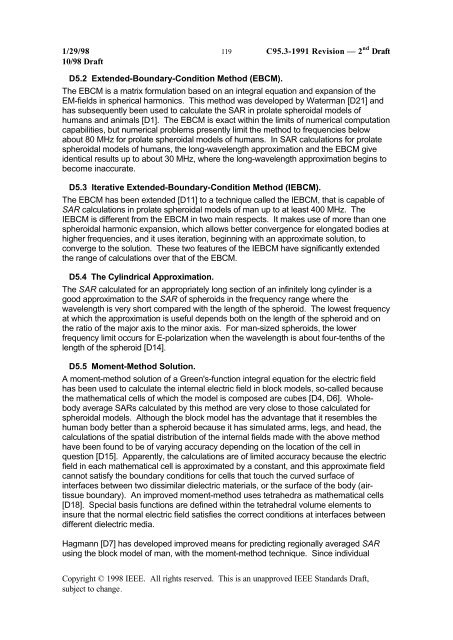DRAFT Recommended Practice for Measurements and ...
DRAFT Recommended Practice for Measurements and ...
DRAFT Recommended Practice for Measurements and ...
You also want an ePaper? Increase the reach of your titles
YUMPU automatically turns print PDFs into web optimized ePapers that Google loves.
1/29/98 119 C95.3-1991 Revision — 2 nd Draft<br />
10/98 Draft<br />
D5.2 Extended-Boundary-Condition Method (EBCM).<br />
The EBCM is a matrix <strong>for</strong>mulation based on an integral equation <strong>and</strong> expansion of the<br />
EM-fields in spherical harmonics. This method was developed by Waterman [D21] <strong>and</strong><br />
has subsequently been used to calculate the SAR in prolate spheroidal models of<br />
humans <strong>and</strong> animals [D1]. The EBCM is exact within the limits of numerical computation<br />
capabilities, but numerical problems presently limit the method to frequencies below<br />
about 80 MHz <strong>for</strong> prolate spheroidal models of humans. In SAR calculations <strong>for</strong> prolate<br />
spheroidal models of humans, the long-wavelength approximation <strong>and</strong> the EBCM give<br />
identical results up to about 30 MHz, where the long-wavelength approximation begins to<br />
become inaccurate.<br />
D5.3 Iterative Extended-Boundary-Condition Method (IEBCM).<br />
The EBCM has been extended [D11] to a technique called the IEBCM, that is capable of<br />
SAR calculations in prolate spheroidal models of man up to at least 400 MHz. The<br />
IEBCM is different from the EBCM in two main respects. It makes use of more than one<br />
spheroidal harmonic expansion, which allows better convergence <strong>for</strong> elongated bodies at<br />
higher frequencies, <strong>and</strong> it uses iteration, beginning with an approximate solution, to<br />
converge to the solution. These two features of the IEBCM have significantly extended<br />
the range of calculations over that of the EBCM.<br />
D5.4 The Cylindrical Approximation.<br />
The SAR calculated <strong>for</strong> an appropriately long section of an infinitely long cylinder is a<br />
good approximation to the SAR of spheroids in the frequency range where the<br />
wavelength is very short compared with the length of the spheroid. The lowest frequency<br />
at which the approximation is useful depends both on the length of the spheroid <strong>and</strong> on<br />
the ratio of the major axis to the minor axis. For man-sized spheroids, the lower<br />
frequency limit occurs <strong>for</strong> E-polarization when the wavelength is about four-tenths of the<br />
length of the spheroid [D14].<br />
D5.5 Moment-Method Solution.<br />
A moment-method solution of a Green's-function integral equation <strong>for</strong> the electric field<br />
has been used to calculate the internal electric field in block models, so-called because<br />
the mathematical cells of which the model is composed are cubes [D4, D6]. Wholebody<br />
average SARs calculated by this method are very close to those calculated <strong>for</strong><br />
spheroidal models. Although the block model has the advantage that it resembles the<br />
human body better than a spheroid because it has simulated arms, legs, <strong>and</strong> head, the<br />
calculations of the spatial distribution of the internal fields made with the above method<br />
have been found to be of varying accuracy depending on the location of the cell in<br />
question [D15]. Apparently, the calculations are of limited accuracy because the electric<br />
field in each mathematical cell is approximated by a constant, <strong>and</strong> this approximate field<br />
cannot satisfy the boundary conditions <strong>for</strong> cells that touch the curved surface of<br />
interfaces between two dissimilar dielectric materials, or the surface of the body (airtissue<br />
boundary). An improved moment-method uses tetrahedra as mathematical cells<br />
[D18]. Special basis functions are defined within the tetrahedral volume elements to<br />
insure that the normal electric field satisfies the correct conditions at interfaces between<br />
different dielectric media.<br />
Hagmann [D7] has developed improved means <strong>for</strong> predicting regionally averaged SAR<br />
using the block model of man, with the moment-method technique. Since individual<br />
Copyright © 1998 IEEE. All rights reserved. This is an unapproved IEEE St<strong>and</strong>ards Draft,<br />
subject to change.
















